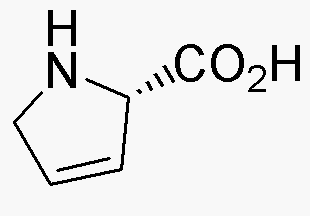3,4-Dehydro-L-proline is widely utilized in research focused on:
- Peptide Synthesis: This compound serves as a valuable building block in the synthesis of peptides, particularly in the development of cyclic peptides that have unique biological activities.
- Pharmaceutical Development: It is used in the design of novel drugs, especially in creating inhibitors for various enzymes, which can lead to advancements in treating diseases like cancer and diabetes.
- Biochemical Research: Researchers leverage its properties to study protein folding and stability, helping to understand diseases related to protein misfolding.
- Material Science: The compound finds applications in the development of new materials, such as hydrogels, which are used in drug delivery systems and tissue engineering.
- Amino Acid Derivatives: It acts as a precursor for synthesizing other amino acid derivatives, which are essential in various biochemical applications and nutritional supplements.
General Information
Properties
Safety and Regulations
Applications
3,4-Dehydro-L-proline is widely utilized in research focused on:
- Peptide Synthesis: This compound serves as a valuable building block in the synthesis of peptides, particularly in the development of cyclic peptides that have unique biological activities.
- Pharmaceutical Development: It is used in the design of novel drugs, especially in creating inhibitors for various enzymes, which can lead to advancements in treating diseases like cancer and diabetes.
- Biochemical Research: Researchers leverage its properties to study protein folding and stability, helping to understand diseases related to protein misfolding.
- Material Science: The compound finds applications in the development of new materials, such as hydrogels, which are used in drug delivery systems and tissue engineering.
- Amino Acid Derivatives: It acts as a precursor for synthesizing other amino acid derivatives, which are essential in various biochemical applications and nutritional supplements.
Documents
Safety Data Sheets (SDS)
The SDS provides comprehensive safety information on handling, storage, and disposal of the product.
Product Specification (PS)
The PS provides a comprehensive breakdown of the product’s properties, including chemical composition, physical state, purity, and storage requirements. It also details acceptable quality ranges and the product's intended applications.
Certificates of Analysis (COA)
Search for Certificates of Analysis (COA) by entering the products Lot Number. Lot and Batch Numbers can be found on a product’s label following the words ‘Lot’ or ‘Batch’.
*Catalog Number
*Lot Number
Certificates Of Origin (COO)
This COO confirms the country where the product was manufactured, and also details the materials and components used in it and whether it is derived from natural, synthetic, or other specific sources. This certificate may be required for customs, trade, and regulatory compliance.
*Catalog Number
*Lot Number
Safety Data Sheets (SDS)
The SDS provides comprehensive safety information on handling, storage, and disposal of the product.
DownloadProduct Specification (PS)
The PS provides a comprehensive breakdown of the product’s properties, including chemical composition, physical state, purity, and storage requirements. It also details acceptable quality ranges and the product's intended applications.
DownloadCertificates of Analysis (COA)
Search for Certificates of Analysis (COA) by entering the products Lot Number. Lot and Batch Numbers can be found on a product’s label following the words ‘Lot’ or ‘Batch’.
*Catalog Number
*Lot Number
Certificates Of Origin (COO)
This COO confirms the country where the product was manufactured, and also details the materials and components used in it and whether it is derived from natural, synthetic, or other specific sources. This certificate may be required for customs, trade, and regulatory compliance.


